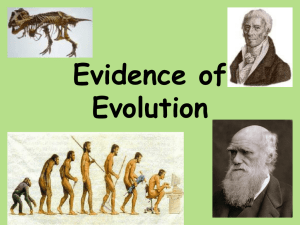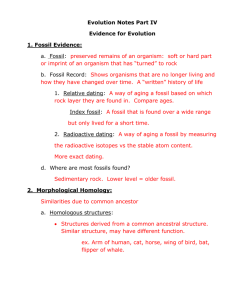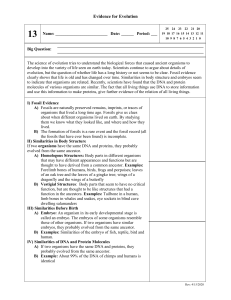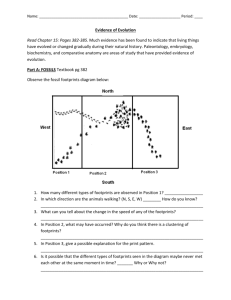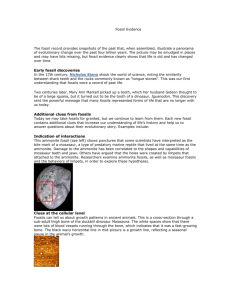evolution rough draft
advertisement
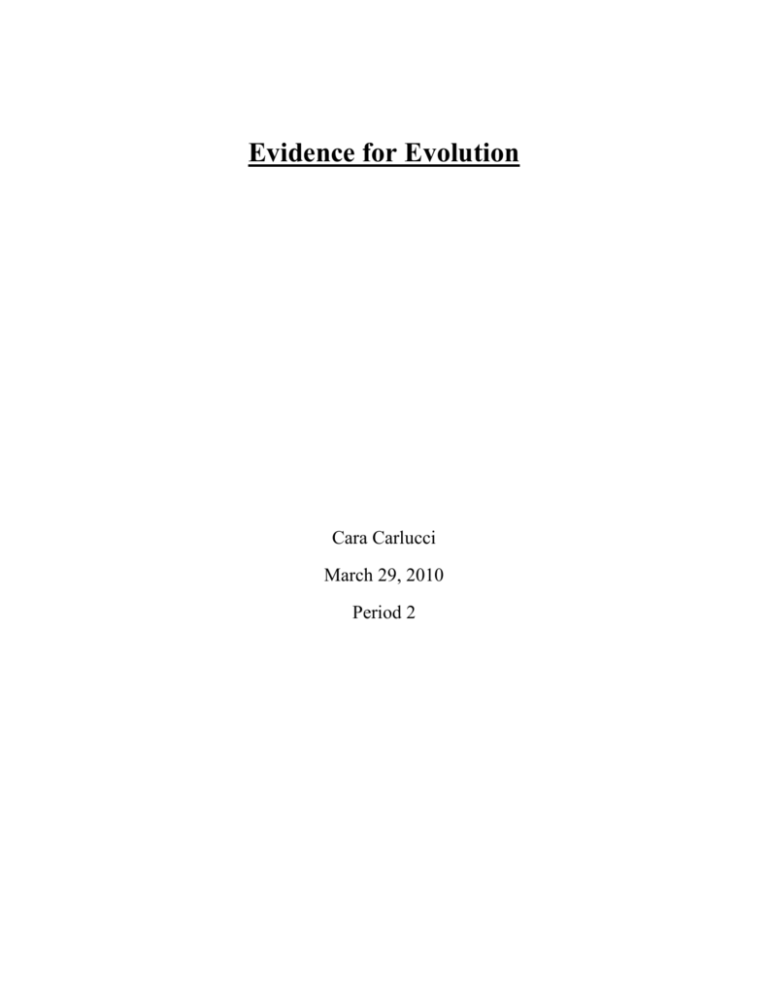
Evidence for Evolution Cara Carlucci March 29, 2010 Period 2 Fossil Evidence The fossil record provides pictures that illustrate evolutionary change over the past four billion years. Fossil evidence can clearly show how old a fossil is, how the fossil has changed over time and fossils can show us the growth patterns of ancient animals. The most common fossils found in sedimentary rocks are the hard parts of organism, including the shells, bones, and the teeth. Even though the fossil record supports evidence that evolution occurred, it is incomplete. Using an inadequate fossil record is like putting together a very confusing puzzle. It’s the same when examining fossils. One example for fossil evidence is the evolution of a camel. With research paleontologists collected using the skull and teeth of camels from millions of years ago; they were able to find how the camel evolved. About 65 million years ago, it started out as a small animal, but as the millions of years went on, it started to get a larger skull, teeth and larger limb bones. Eventually, the camel evolved into how it looks today over a long period of time. Another example is the picture at the bottom of the page which shows a cross-section through a sub-adult high bone of the duckbill dinosaur Maiasaura. The white spaces in the picture show that there were a lot of blood vessels that ran through the bone, which tells us it was a fast-growing bone and the black wavy lines are showing a growth line which is a seasonal pause in an animal’s growth. For example in 1799 an engineer named William Smith reported that, in undisrupted layers of rock, fossils occurred in a definite sequential order, with more modern-appearing ones closer to the top. Because bottom layers of rock logically were laid down earlier and they are older than top layers, the sequence of fossils also could be given a chronology from oldest to youngest. His findings were confirmed and extended in the 1830s by the paleontologist William Lonsdale, who recognized that fossil remains of organisms from lower strata were more primitive than the ones above. Today, thousands of ancient rock deposits have been identified that show corresponding successions of fossil organisms. Thus, the general sequence of fossils had already been recognized before Darwin conceived of descent with modification. The paleontologists and geologists before Darwin used the sequence of fossils in rocks not as proof of biological evolution, but as a basis for working out the original sequence of rock strata that had been structurally disturbed by earthquakes and other forces. In Darwin's time, paleontology was still a rudimentary science. Steering Committee on Science and Creationism, and National Academy of Sciences. "Science and Creationism: A View from the National Academy of Sciences." The National Academies Press. N.p., 1999. Web. 23 Mar. 2010. <http://www.nap.edu/openbook.php?record_id=6024&page=11>. Steering Committee on Science and Creationism, and National Academy of Sciences. "Science and Creationism: A View from the National Academy of Sciences." The National Academies Press. N.p., 1999. Web. 23 Mar. 2010. <http://www.nap.edu/openbook.php?record_id=6024&page=11>. Anatomy The evolutionary theory anticipates that mutual organisms will share similarities that are determined from common ancestors. In anatomy, when organisms have similar characteristics, it is called homologies. Homologies can be brought out by comparing the anatomies of different organisms, studying embryological development or studying vestigial structures. In the picture, each leaf has a different shape and different function, but they are all homologous structures that are from a common ancestor. In the picture, the pitcher plant and the Venus’ flytrap use leaves to trap and then digest insects. The red leaves of the poinsettia look like flower petals and the cactus leaves are modified into small spines which reduce water loss and might protect the cactus from herbivores. A lot of animals like pigs, deer, dogs and cattle have reduced, nonfunctional digits, referred to as dewclaws. The foot of a pig has lost digit 1 completely, digits two and five have been greatly reduced and only digits three and four support their body. Evolution explains vestigial features. A vestigial structure is a body part that has become small and lost its use because of evolutionary change. Whales, for example, have small bones located in the muscles of their body walls that are vestigial bones of hips and hind limbs. People and apes have chests that are broader than they are deep with the shoulder blades that are flat in back. That is because we, like apes, are descended from an ancestor who was able to suspend itself using the upper limbs. But on the other hand, monkeys and other quadrupeds have different forms of locomotion and quadrupeds have narrow, deep chests with shoulder blades on the sides. Modern organisms are adapted to a wide variety of habitats and lifestyles. The forelimbs of birds and mammals, for example, are variously used for flying, swimming, running over several types of terrain, and grasping objects such as branches and tools. Despite this enormous diversity of function, the internal anatomy of all bird and mammal forelimbs is remarkably similar. It is inconceivable that nearly the same bone arrangement could be ideal for different functions, as we would expect if each animal had been created separately. Such similarity is exactly what we would expect, however, if bird and mammal forelimbs were derived from a common ancestor. Through natural selection, each has been modified to perform a particular function. Such internally similar structures are called homologous structures, meaning that they have the same evolutionary origin despite possible differences in function. http://evolution.berkeley.edu/evolibrary/article/0_0_0/lines_05 Biochemistry Biochemistry reveals the similarities between organisms of different species. For example the metabolism of different organisms is based on the same complex biochemical compounds. Certain blood proteins found in almost all organisms give additional evidence that these organisms descended from a common ancestor. These biochemical compounds, including cytochrome c and blood proteins, are so complex that it is unlikely that almost all identical compounds would have evolved independently in widely different organisms. Cytochrome c is primarily known for its function in the mitochondria as a key participant in the life-supporting function of ATP synthesis. However, when a cell receives an apoptotic stimulus, cytochrome c is released into the cytosol and triggers programmed cell death through apoptosis. Further studies of cytochrome c in different species reveal variations in the amino acid sequence of this molecule. For example, the cytochrome c of monkeys and cows is more similar than the cytochrome c of monkeys and fish. Scientists have similarly compared the biochemistry of universal blood proteins. Their studies reveal evidence of degrees of relatedness between different species. This evidence implies that some species share a more recent common ancestor than other species do. From the evidence, scientists have inferred the evolutionary relationships between different species of organisms. The picture shows that embryos of certain species develop almost identically, especially in the early stages. Physical similarities indicate that there are genetic similarities between the organisms. These similarities can be evidence that the organisms in the picture probably came from a common ancestor. The similarities between living species in ancestry, in homologous and vestigial structures, in embryological development, and in biochemical compounds all could be explained as extremely remarkable coincidences. However, a more probable explanation of the similarities of species arising is by descent and modification from more ancient forms. Additionally, the fossil record, contributes compelling evidence that species have changed over time. Prokaryotic cells almost certainly preceded eukaryotic cells, and the evolution of so extremely complex an apparatus as the mitotic spindle (which ensures equal segregation of replicated chromosomes) must have taken very long periods of time to evolve. The development of mitochondria and chloroplasts (each of which contains its own DNA) in the eukaryotic cell may have been the result of a symbiosis, a cooperative arrangement entered into at first tentatively by originally free-living cells. Humans have a tailbone at the end of the spine that is of no apparent use. Some snakes have tiny pelvic bones and limb bones, and some cave-dwelling salamanders have eyes even though members of the species are completely blind. Such seemingly functionless parts are called vestigial organs or structures. http://bioweb.cs.earlham.edu/9-12/evolution/HTML/live.html Embryology Even before Charles Darwin proposed the theory of evolution through natural selection, Ernst von Baer claimed that the more closely related any two species are, the more similar their development will be. His treatise (1828) set the stage for the linking study of ontogeny, the development of the individual through a single life cycle, to phylogeny, the relatedness of species through descent from a common ancestor. When Darwin brought together the diverse lines of evidence to demonstrate that new species arose from previous species, he included the findings from studies on embryos. Von Baer discovered the mammalian egg as part of his detailed studies on animal development, observed that vertebrate animals, during the early stages of their embryological development, seem to have common design whereas the adult forms show a difference. Arm buds from different species, for example, are virtually indistinguishable, when they first form on the embryo, yet they may develop into a wing, an arm or a flipper. In the early stages of growth when vital organs originate, the developmental sequences, or ontogeny, of all vertebrates are similar. As the fertilized egg transforms into an adult, the general vertebrate plan is modified during growth as each species acquires its adult species pattern. For example, a plate shows six developmental stages of five species of vertebrates- one amphibian (a salamander), one bird (a chicken), and three mammals (a pig, monkey and a human). The similarities of body shapes among the five species in early developmental stages are very close. The late fetal/newborn/adult stages reflect the emergence of species-specific body plans as a result of differential growth. The fertilized eggs or zygotes are really similar, though they differ slightly in the size of the nucleus. The orderly division of the single celled zygote into a multicelled blastocyst is referred to as cleavage. By the late cleavage stage, the embryos look very similar, though they differ only in their cleavage patterns, which vary due to the presence of differing amounts of yolk in the egg. As the body segments form, all three mammals remain almost identical. The ancestral gill slits which in the mammals will later develop into parts of the ear and pharynx. The mammals possess an umbilical cord that leads to the placenta. In contrast, the salamander and the chicken are nourished by the yolk. The early forelimb begin as buds and by the late fetal stage, limbs take on their adult shapes. The striking similarities in the late fetal stage between monkey and human reflect their close phylogenetic relationship. The main differences lie in the absence of a tail in the human fetus. The chicken has developed its specialized shell breaker. http://www.pbs.org/wgbh/evolution/library/04/2/pdf/l_042_03.pdf

